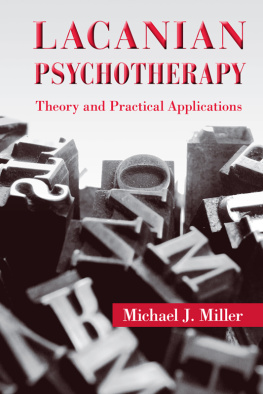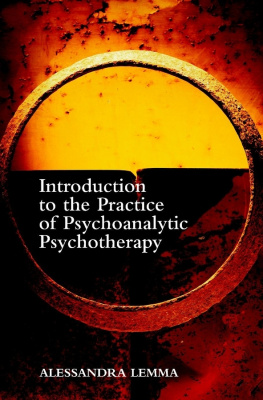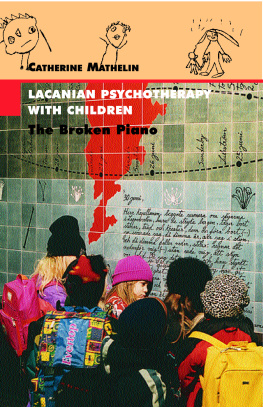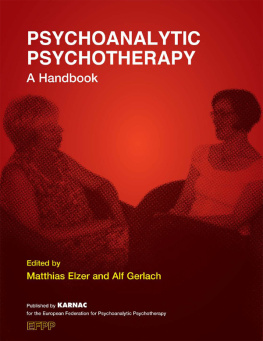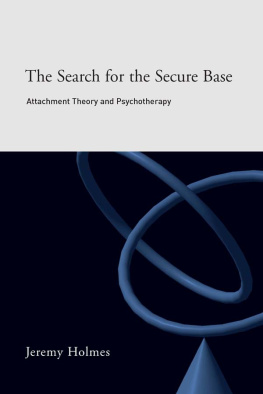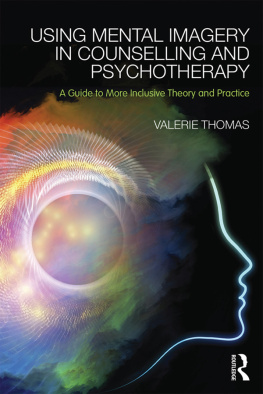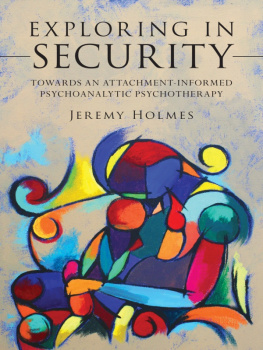LACANIAN
PSYCHOTHERAPY
LACANIAN
PSYCHOTHERAPY
Theory and Practical Applications
Michael J. Miller

Routledge
Taylor & Francis Group
711 Third Avenue
New York, NY 10017
Routledge
Taylor & Francis Group
27 Church Road
Hove, East Sussex BN3 2FA
2011 by Taylor and Francis Group, LLC
Routledge is an imprint of Taylor & Francis Group, an Informa business
International Standard Book Number: 978-0-415-89304-6 (Hardback) 978-0-415-89305-3 (Paperback)
For permission to photocopy or use material electronically from this work, please access www.copyright.com (http://www.copyright.com/) or contact the Copyright Clearance Center, Inc. (CCC), 222 Rosewood Drive, Danvers, MA 01923, 978-750-8400. CCC is a not-for-profit organization that provides licenses and registration for a variety of users. For organizations that have been granted a photocopy license by the CCC, a separate system of payment has been arranged.
Trademark Notice: Product or corporate names may be trademarks or registered trademarks, and are used only for identification and explanation without intent to infringe.
Library of Congress Cataloging-in-Publication Data |
Miller, Michael J. (Michael Joseph), 1976- author. Lacanian psychotherapy: theory and practical applications/Michael J. Miller. p.; cm. Includes bibliographical references and index. ISBN 978-0-415-89304-6 (hardcover: alk. paper) -- ISBN 978-0-415-89305-3 (softcover : alk. paper) -- ISBN 978-0-203-81709-4 (e-book) 1. Psychoanalysis. 2. Lacan, Jacques, 1901-1981. I. Title. [DNLM: 1. Lacan, Jacques, 1901-1981. 2. Psychoanalytic Theory. 3. Psychoanalytic Therapy--methods. WM 460] RC506.M525 2011 616.8917--dc22 2010047978 |
Visit the Taylor & Francis Web site at
http://www.taylorandfrancis.com
and the Routledge Web site at
http://www.routledgementalhealth.com
Dedicated to my grandmother, Jean, with gratitude
for all she has taught me about love and healing.
Lucky us.
Contents
Acknowledgments
T his book exists primarily because of the trust, hard work, and awe-inspiring resilience and inner health of the patients I have written about here. I also owe a huge debt to the support, direct and indirect, of many great friends and colleagues. Chief among them is Dr. Bruce Fink, who introduced me to clinical and serious theoretical thinking about Lacan, and who has kindly tolerated the way I have twisted his lessons into what you are about to read. He contributed close reading and thoughtful critique during the early stages of the manuscript. My great thanks go also to Routledge, and especially Kristopher Spring, for taking a chance on this publication. I am also grateful for the support and helpful comments and suggestions of Drs. Paul Richer and Russell Walsh of Duquesne University. Dr. Jamie Ghany read this manuscript in its entirety several times over, somehow retained her good will toward me, and provided extremely valuable feedback. Dr. Sipho Mbuqe and Rong-Bang Peng provided support, commentary, and thoughtful discussion of all things psychoanalytic, philosophical, and beyond throughout the writing process.
About the Patients
A ll identifying information has been removed from or heavily disguised in the following case studies, so that no reader (except, possibly, the patient her- or himself) will be able to identify who is being discussed. The symbolic relationships between aspects of these patients stories, however, have been preserved.
Introduction: AnOther Psychoanalysis
Man thus speaks, but it is because the symbol has made him man.
Lacan (1953, p. 65)
Lacans Absence from the American Clinic
Nearly a century after Freud (1918) first took up the question of the narcissism of minor differences, the culture of psychoanalysis seems to have taken that art to new heights. An extraordinary appetite for factionalism, even as psychoanalysis in general languishes at the margins of American psychology, continues to splinter its adherents into innumerable camps. Indeed, it seems as though there may be as many types of psychoanalysis as there are theoreticians and practitioners. But this is not entirely a bad thing. This tradition imparts to the student of psychoanalysis an embarrassment of theoretical riches, the opportunity to listen closely to any of the numerous voices from the dissonant chorus, and the challenge to test them philosophically in ways that often transcend simple questions of treatment efficacy.
Some voices are, of course, louder than others. In the United States, the legacy of ego psychology still looms large, while the relational turn dominates much of current discourse. And one arguably important voice is barely audible above the others.
A student of psychodynamic therapy in this country is hardpressed to find a legitimate clinical education that involves any academic or practical work based on Jacques Lacans contributions to psychoanalysis. Her exposure to Lacan is much more likely to come in the form of what she overhears in departments of literature and philosophy than it is to come from her psychological training. If the clinician in training wishes to take up Lacan clinically, she is largely on her own, even in psychoanalytic training institutes, faced with a shortage of mentorship, clinical literature, and camaraderie of like-minded professionals.
This is ostensibly not without reason. In the first place, Lacans writing is often thought of as too bizarre and opaque to be rewarding to the reading clinician. This criticism is not entirely baseless: Lacans prose is arguably on a par with James Joyces in its level of obscurantism. But when challenged on these grounds, Lacan (1975/1998, p. 26) himself responded by declaring that his writing was never meant to be read, least of all by idiots (Lacan & Copjee, p. xxv). Such narcissistic rhetoric does little to ingratiate Lacan to readers who may be put off by his style. Yet for the challenge he represents to the reader, does Lacan deserve to be left aside by American psychotherapy, or is there something more that he has to offer us? To look at the more enthusiastic response his work has garnered in other parts of the world, one cannot but suspect that there is.
However obscure Lacans writing may be, and however far from the American psychoanalytic (and therefore psychodynamic) mainstream it may remain, it should give us pause to realize his effect in other places, both geographic and academic. Curiously, as his analysand Stuart Schneiderman (1983) put it, Lacan made a very successful career out of saying things that just about no one could understand (p. vi). One measure of that success might be found in the fact that 4 years after his death in 1981, 19 of the 20 existing psychoanalytic organizations in France were basing their work on the teachings of Jacques Lacan (Nobus, 2000, p. 213). Along the way, he enlisted intellectuals of all stripesphilosophers, anthropologists, and most importantly for our purposes, cliniciansin an important rebellion against the psychoanalytic status quo of his time.
The nature of that rebellion, which I will discuss in the pages that follow, may have just as much to do with Lacans lack of popularity in the United States as does his convoluted prose. Lacans work was anything but kind to the strain of psychoanalysis made popular here under the auspices of Hartmann, Kris, and Loewenstein, among others (see Fink, 2004). Hence, the experience of the American analyst or analytic therapist who reads Lacan is made doubly unpleasant: Why spend time and effort reading work that insults not only the reader, but his ideological forbears as well, and does so in a way that is barely intelligible?
Next page
